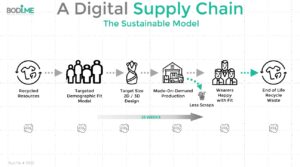It’s fair to say that COP27 didn’t live up to expectations. The troubled UN climate summit in Sharm el-Sheikh, Egypt, did not deliver the kind of progress many had been hoping for, and the impact of the fashion industry – widely considered to be among the most polluting sectors – was not as high up the agenda as in previous years.
The current decarbonisation path
Simon Steill, executive secretary for UN’s Framework Convention on Climate Change (UNFCCC), opened the event by saying: ‘No one can be a passenger on this journey.’ But the lack of a robust outcome on emissions reduction was disappointing, and underlines the need for the world – and the fashion industry – to do more.
As Paul Polman wrote on Fortune.com, the world is currently on course for a ruinous 3ºC temperature rise, with attempts to improve on this hampered by the fossil-fuel lobby.
The fashion industry is doing no better. Mckinsey estimates that if the fashion industry continues to decarbonise at its current rate, it will miss the pathway to 1.5°C by a staggering 50%. Federica Marchionni, CEO of the Global Fashion Agenda, which runs an annual sustainable fashion conference in Copenhagen and hosted three events at COP27, said bluntly: ‘The fashion industry is far from where it should be.’
There was some good news, however, with the establishment of the ‘Loss and Damage’ fund that will at last see the nations of the rich global north take responsibility for and support poorer nations with the consequences of climate change.

What can be done?
Fashion urgently needs to decarbonise. Fundamentally, the industry needs to change its resource-intensive supply chain and production model – the majority of a garment’s emissions occur during materials processing and manufacturing stages. However, the solution is two-fold – a reduction in production to sustainable levels and a decrease in individual consumption. Do we really need quite so many new clothes?
Hot or Cold analysed the production and consumption of G20 countries in its report Unfit, Unfair, Unfashionable. Australia has the highest carbon footprint per capita when it comes to fashion consumption at 502kg CO2e per year. It is followed by the US (387kg) Japan (309kg), the UK and South Korea (373kg). By contrast, the fashion carbon footprint per capita per year in India is just 22kg CO2e.

Clothing consumption per person has increased steadily in the last three decades – by up to 40% in the EU alone. This is in large part thanks to the steadily decreasing price of fashion over the same period as a result of the move offshore. But this merely underlines the need for change. The harsh truth, according to Hot or Cold’s research, is that if the 1.5ºC is to be met, we need to reduce our consumption of fashion significantly – to just 128.7kg CO2e per capita per year.

Bodi.Me can help tackle the problem from both ends by providing valuable insight into your customers with our Size-Me fashion fit technology platform. By helping consumers select the best fit through fast and accurate size recommendation tools, Size-Me can reduce returns, optimise stock levels, improve sell-through, and help businesses focus production on the sizes that sell. This in turn helps tackle fashion’s waste problem by minimising unsold clothes going to landfill and incineration.

